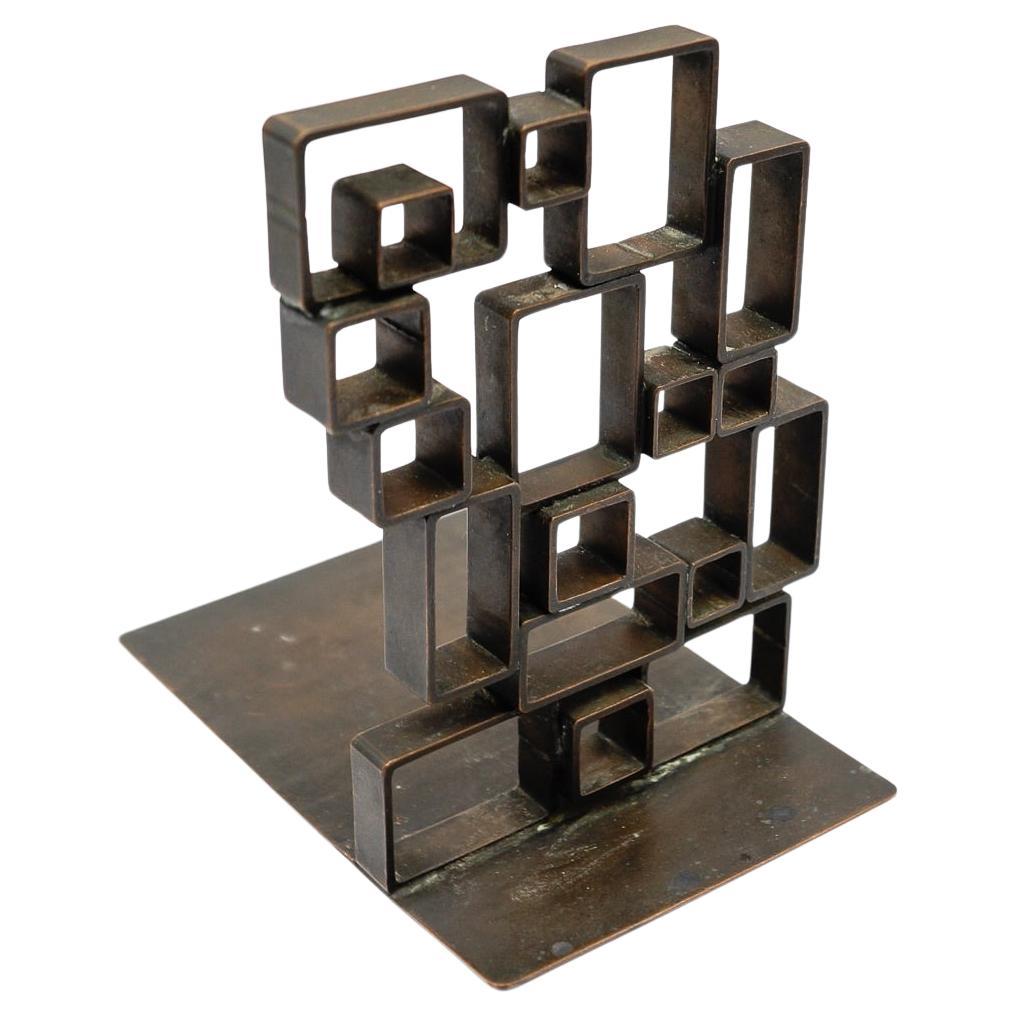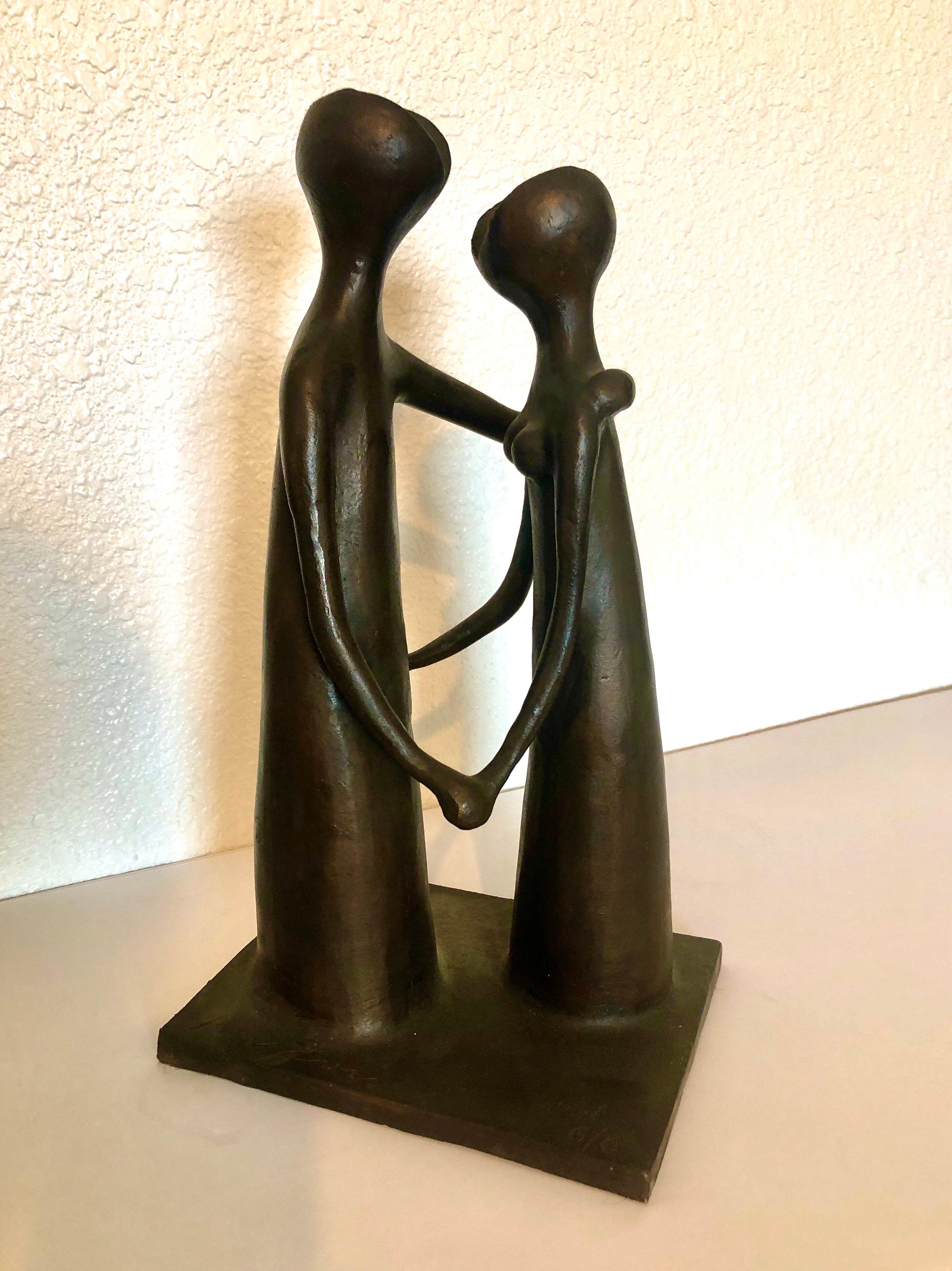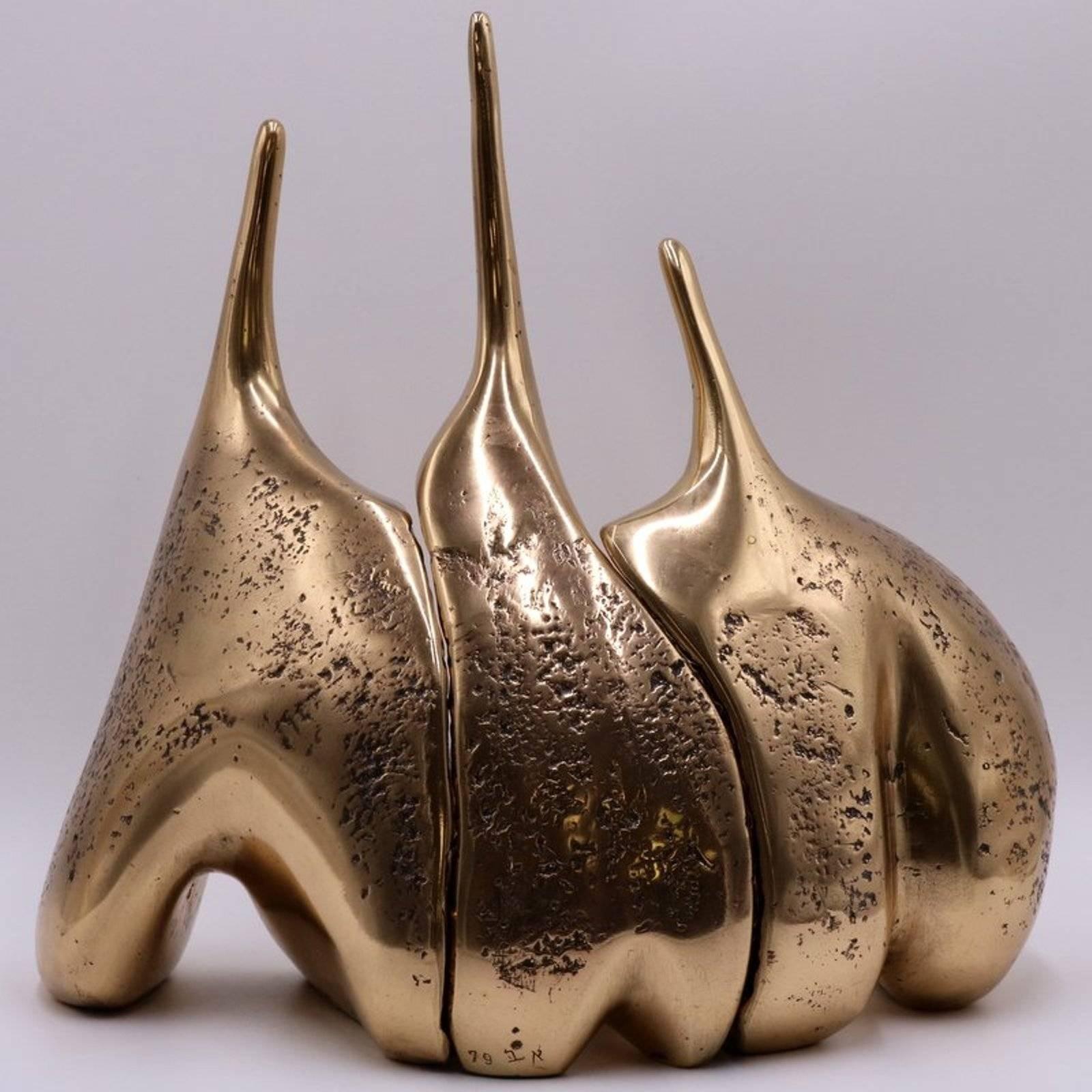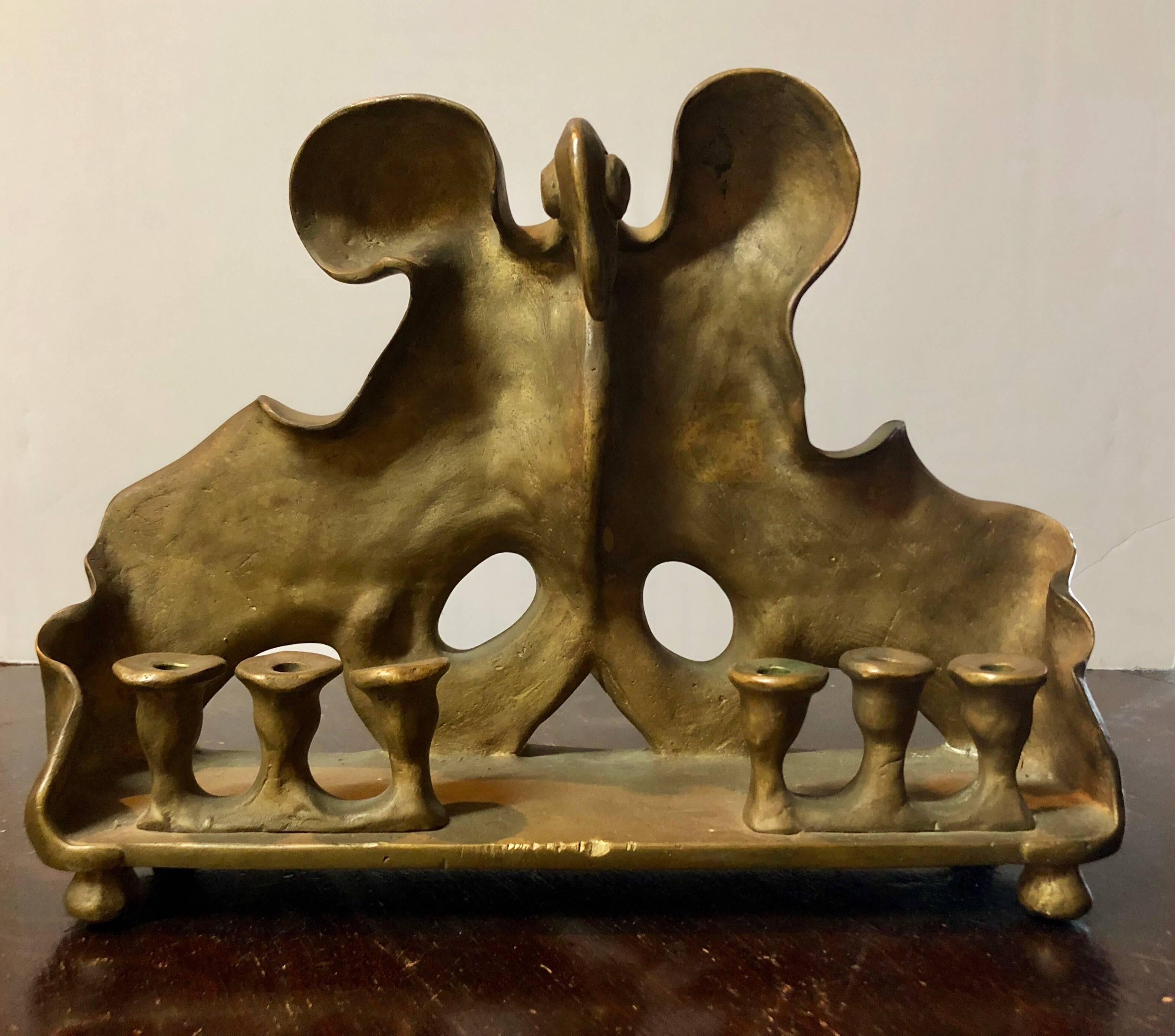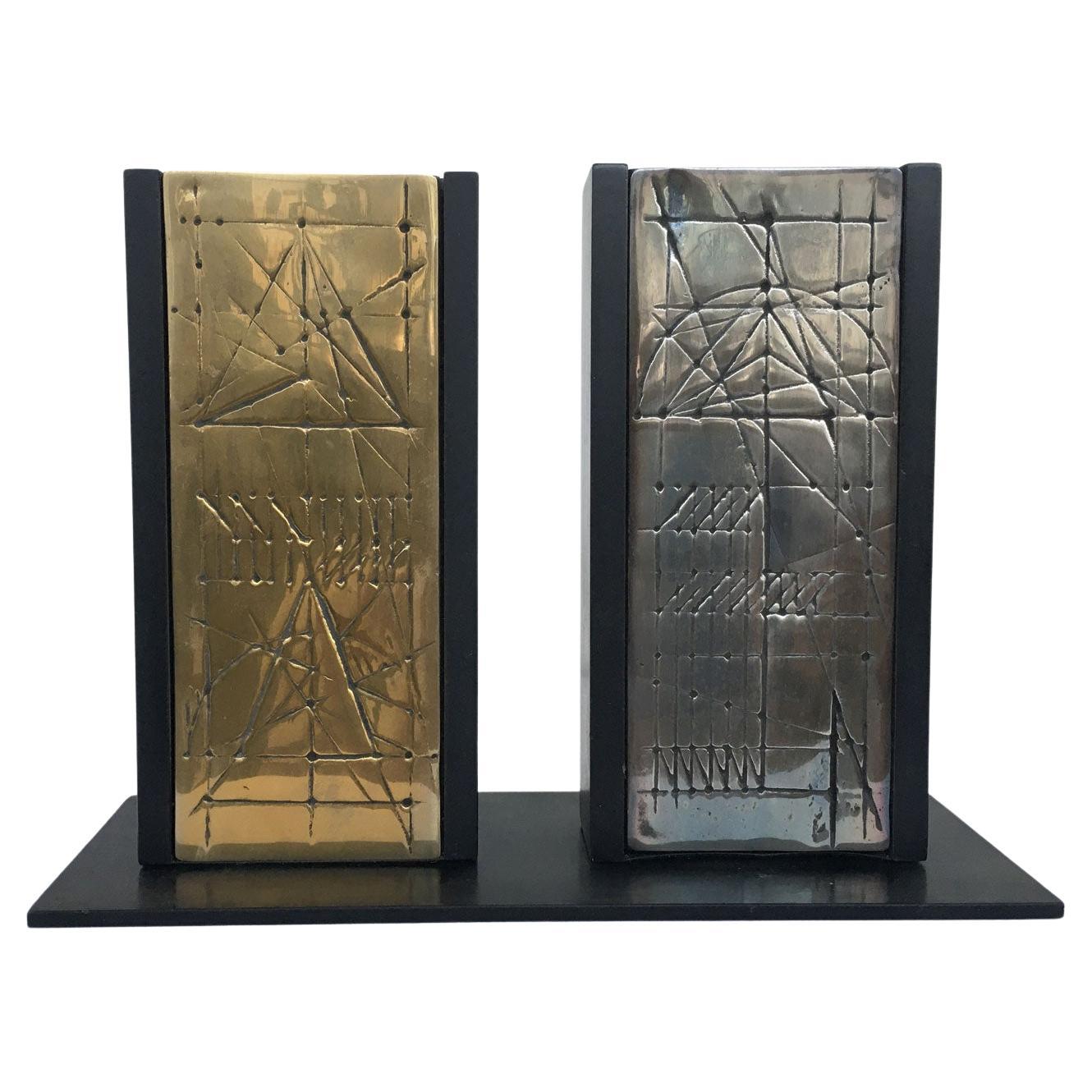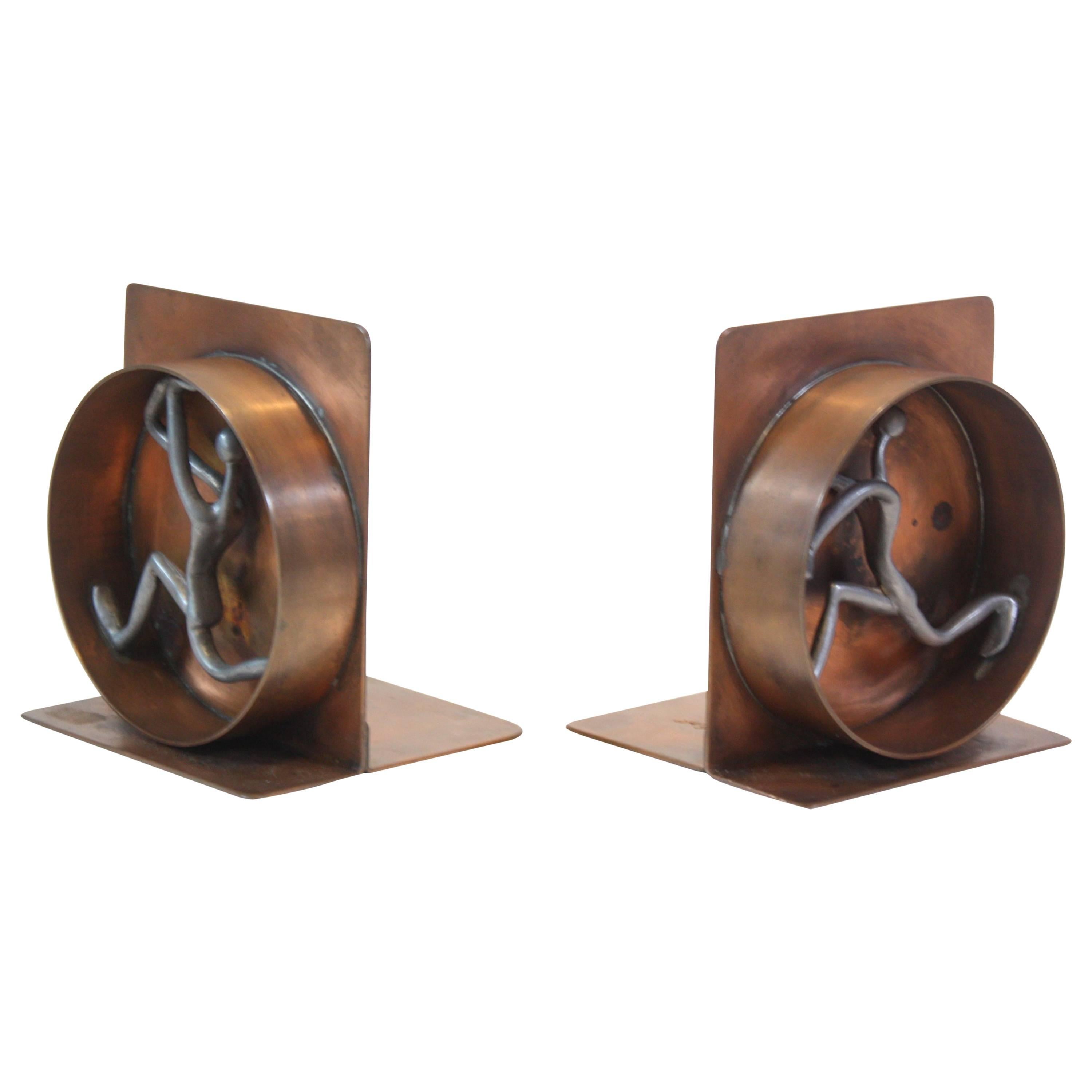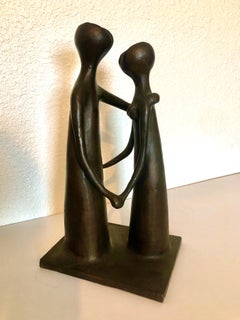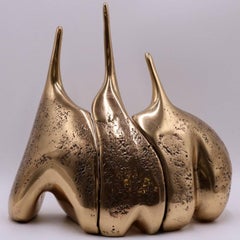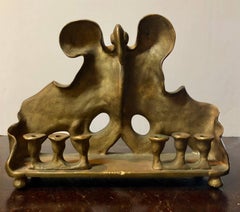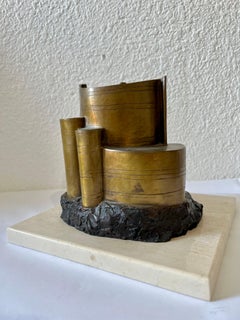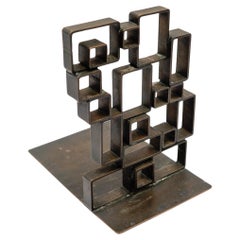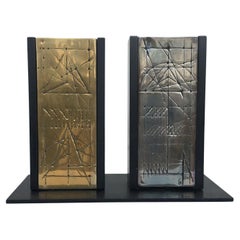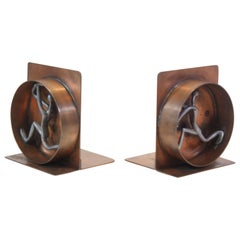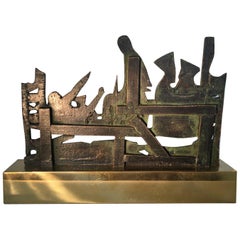Items Similar to Israeli Mod Arts & Crafts Copper Sculpture Bookends Bezalel Schatz Yaad Studio
Want more images or videos?
Request additional images or videos from the seller
1 of 16
Israeli Mod Arts & Crafts Copper Sculpture Bookends Bezalel Schatz Yaad Studioc.1960s
c.1960s
$650
£496.50
€570.53
CA$927.88
A$1,017.35
CHF 531.25
MX$12,242.49
NOK 6,695.57
SEK 6,295.55
DKK 4,260.82
About the Item
Bezalel Schatz, (1912-1978), Yaad Studio Workshop
Mid century modern
The standing part is 6 X 5 inches. The copper sheet is 10 X 5 inches each. This is for a pair. they are copper with a jewel (bakelite?) element bezel set into it. Hand made in israel handwrought Sculpture of Jerusalem walls, in Silver copper modernist jeweled design, engraving and hammer work, with a whimsical mod architectural design decorations. From the YAAD workshop of Bezalel Schatz, son of Boris Schatz.
Can be used as bookends. there is a pair.
Bezalel Schatz, (1912-1978), Jerusalem. Son of Boris Schatz, founder of Bezalel Academy, Jerusalem. 1930-51 Lived in USA. Designed numerous works for public places in Israel. Was active on public committees and art organisations. Died 1978.
Education
1926-1920 Bezalel Academy of Arts and Design, Jerusalem
1927 Hebrew Gymnasia, Jerusalem
1933? De la Grande Chaumiere Academy of Arts, Paris, France
Awards And Prizes
1954 Gold Medal, The Triennale of Applied Arts, Milan, Italy. Schatz lived in Israel, New York, and Northern California where he was part of the Big Sur artists writers' colony that included San Francisco sculptor Benny Bufano, author Henry Miller, and his sister Zahara Schatz.
Zahara and Bezalel rejected their father's predilection for Romantic Classicism and his dogged development of a Jewish Eretz Israel style in favor of a European-American modernism. With an emphasis on space age sputnik design. Bezalel (nicknamed “Lilik”) Schatz was an Israeli artist, son of Boris Schatz, founder of the Bezalel School of Arts and Crafts in Jerusalem.
Born in 1912 to Boris Schatz, and his wife Olga, an art critic. From an early age, he demonstrated considerable talent for gymnastics and music, but especially for art. He grew up in a home in which artists were a constant presence, he was introduced to Israel’s most prominent leaders, and the first public exhibition of his artwork coincided with his Bar Mitzvah celebration. He attended the Gymnasia in Jerusalem and at age 14 completed his studies at the Bezalel School.
In 1930, Bezalel joined his father on a fundraising tour of Europe and the United States, where they also exhibited their artwork and that of Bezalel students. Following his father’s death in 1932, Bezalel left Israel for a period of about two decades. He spent the first four years studying at the Grand Chaumiere Academy in Paris. There, given the fairly conservative artistic views he had acquired at home and school – where modernism was denounced – he had to pave his own way as an artist among his peers.
Between 1937 and 1951, Bezalel resided in the U.S. Near the end of WWII, he worked in a California shipyard, and it was there he met his future wife, Louise. He was also introduced to the novelist Henry Miller in California, and their friendship blossomed into a creative collaboration. The artist May Ray recorded his observations about the two, noting that “I have never encountered such smooth cooperation…” Bezalel produced silkscreen prints for Miller’s novel, Into the Night Life, an innovation for both the art and publishing worlds. In Florence, New Mexico, New York, San Francisco, and other locations, Bezalel exhibited his own work and participated in group shows with some of the greatest artists of his era – Pablo Picasso, Henri Matisse, Marc Chagall, and Oskar Kokoschka.
Bezalel and Louise married in 1948 and moved to Israel three years later, taking residence in the Schatz house in Jerusalem. Despite his long absence from Israel and his conceptual conflicts with artists there, Bezalel mounted several exhibitions and represented his native country abroad – in Germany and at Venice’s 1954 Biennale, for example. Together with Louise Schatz and his sister, Zahara Schatz, he established the arts and crafts workshop, “Yad.” Handmade modernist folk art objects created there today are displayed and sold in a small building on the grounds of the family home on Bezalel Street in Jerusalem. When the Ein Hod artists’ village was founded in 1953, Bezalel and Louise moved to a home designed for them there by Israeli architect David Reznik. The couple melded easily into the village’s Bohemian artistic life, which resembled the lifestyle they had adopted in California.
Bezalel was an easy-going, congenial man of whom Henry Miller remarked, “Bezalel is an incorrigible optimist, the greatest optimist I ever met.” After his return to Israel, Bezalel’s most pleasurable moments were in the company of his small family and most intimate friends. He also continued to correspond with his friends in the U.S. He refrained from expressing his intellectual insights, either verbally or in writing, and never attempted to justify his work in any way. He was a productive post modernist artist and craftsman – vigorous, sensitive, and curious – and he contributed significantly to Israel’s aesthetic environment and art. His inspiration flowed from many different sources, from primitive tribes, to Biblical tales, Western art, the nature and history of Israel, and the symbols of his homeland that had also inspired his father.
Bezalel’s art work exemplified many different techniques. His early works adhered to the realistic/academic style he learned at the Bezalel art school. Later, his development was influenced by abstract art. His works included sketches, prints, oil painting reliefs, hand made copper engravings, applied art, graphic art, ceramic, and Judaica. In the last decade of his life, his major artistic endeavor was mural design. Among his public works were artwork for ships owned by the Israeli company Zim, the gates at the entrance to the President’s Residence in Jerusalem, and a fence in the courtyard area of the Western Wall.
Bezalel died in Jerusalem in 1978.
Betzalel Schatz: Oil Paintings and Drawings The Bezalel National Museum, Jerusalem 1953
Group Exhibitions Israeli Art Exhibition. Rome, Italy, 1954
Artists: Mordecai Ardon, Moshe Tamir, Yehezkel Streichman, Aharon Kahana, Anna Ticho, Naftali Bezem.
Forms From Israel Mounting Exhibition, USA, 1958
Artists: Jean David, David Gumbel, David Palombo, Avigdor Arikha.
Ein Hod Artisrs Village - Tenths Year Anniversary Exhibition, 1963
Artists: Zvi Aldouby, Marcel Janco, Moshe Mokady, Yohanan Simon, Dov Feigin, Itche Mambush.
- Attributed to:Bezalel Schatz (1912-1983)
- Creation Year:c.1960s
- Dimensions:Height: 6 in (15.24 cm)Width: 5 in (12.7 cm)
- Medium:
- Movement & Style:
- Period:
- Condition:
- Gallery Location:Surfside, FL
- Reference Number:1stDibs: LU38214976592
About the Seller
4.9
Platinum Seller
Premium sellers with a 4.7+ rating and 24-hour response times
Established in 1995
1stDibs seller since 2014
1,817 sales on 1stDibs
Typical response time: 1 hour
- ShippingRetrieving quote...Shipping from: Surfside, FL
- Return Policy
Authenticity Guarantee
In the unlikely event there’s an issue with an item’s authenticity, contact us within 1 year for a full refund. DetailsMoney-Back Guarantee
If your item is not as described, is damaged in transit, or does not arrive, contact us within 7 days for a full refund. Details24-Hour Cancellation
You have a 24-hour grace period in which to reconsider your purchase, with no questions asked.Vetted Professional Sellers
Our world-class sellers must adhere to strict standards for service and quality, maintaining the integrity of our listings.Price-Match Guarantee
If you find that a seller listed the same item for a lower price elsewhere, we’ll match it.Trusted Global Delivery
Our best-in-class carrier network provides specialized shipping options worldwide, including custom delivery.More From This Seller
View AllIsraeli Bronze Sculpture Lovers Embrace Abstract Modernist Ein Hod Israel
By Gedalia Ben Zvi
Located in Surfside, FL
Bronze sculpture signed in Hebrew and numbered from small edition of 6
BIOGRAPHY
"I was born in Czechoslovakia in the year 1925, of traditional parents. I spent my youth partly in ...
Category
Mid-20th Century Modern Figurative Sculptures
Materials
Bronze
Rare Aharon Bezalel Israeli Gilt Modernist Bronze Sculpture Suite
By Aharon Bezalel
Located in Surfside, FL
The width dimensions are variable. the tallest height is 11.5 inches. Family group. A suite of three bronze sculptures.
Aharon Bezalel (born Afghanistan 1926) Born in Afghanistan in 1926 and immigrated to Israel at an early age. As a youth was engaged as a silversmith and craftsman, and was a student of the sculptor Zev Ben-Zvi from whom he absorbed the basic concepts of classic and modernist art and interpreted, according to them, ideas based on ancient Hebrew sources.
Aharon Bezalel works and resides in Jerusalem, he taught art for many years.
“I saw myself as part of this region. I wanted to find the contact between my art and my surroundings. Those were the first years of Jean Piro’s excavations at the Beer-Sheba mound. They found there, for example, the Canaanite figurines that I especially liked and that were an element that connected me with the past and with this place.” “…a seed and sperm or male and female. These continue life. The singular, the individual alone, cannot exist; I learned this from my father who dabbled with the Kabbalah.”
(Aharon Bezalel, excerpt from an interview with David Gerstein)
“The singular in Aharon Bezalel’s work is always potentially a couple if not a threesome[…] the one is also the many: when the individual is revealed within the group he will always seek a huddling, a clinging together.
The principle of modular construction is required by this perception of unity and multiplicity, as modular construction in his work is an act of conception or defense.
Two poles of unity, potentially alone, exist in A. Bezalel’s world: From a formal, sculptural sense these are the sphere and pillar, metaphorically these are the female in the final stages of pregnancy and the solitary male individual. Sphere-seed-woman; Pillar-strand-man. The disproportional, small heads in A. Bezalel’s figures leave humankind in it’s primal physical capacity. The woman as a pregnancy or hips, the man as an aggressive or defensive force, the elongated chest serves as a phallus and weapon simultaneously.
(Gideon Ofrat)
EIN HAROD About the Museum's Holdings: Israeli art is represented by the works of Reuven Rubin, Zaritzky, Nahum Gutman, Mordechai Ardon, Aharon Kahana, Arie Lubin, Yehiel Shemi, Yosl Bergner and others.
The graphic arts collection contains drawings and graphic works by Pissaro, Modigliani, Pascin, Chagall (almost all of his graphic work), and numerous other artists. The sculpture collection includes works by Jewish sculptors from all over the world including leading Israeli sculptors; Ben Zvi, Lishansky, David Palombo, Yehiel Shemi, Aharon Bezalel and Igael Tumarkin.
Many Jewish sculptors from all parts of the world, beginning with Antokolski, are represented in the collection. In the sculpture courtyard there are works by Chana Orloff, Jacob Epstein (the works he bequeathed to the Museum), Glicenstein, Loutchansky, Constant and Indenbaum from Western Europe; Glid from Yugoslavia; Zorach, Gross and Harkavy from the United States; and most of the outstanding sculptors of Israel : Ben-Zvi, Lishansky, Ziffer, Lehmann, Feigin, Sternschuss, Palombo ( who executed the iron gate...
Category
1970s Expressionist Abstract Sculptures
Materials
Bronze
RARE Judaica Holocaust Memorial Menorah Bronze Sculpture
By Mosheh Oved
Located in Surfside, FL
Moshe Oved (aka Edward Good) was a Polish-British, jeweler, artist, sculptor and Yiddish author and founder of the antique jewelry shop Cameo ...
Category
Early 20th Century Aesthetic Movement Figurative Sculptures
Materials
Bronze
Bronze Abstract Space Age Book Sculpture LA California Modernist Charna Rickey
By Charna Rickey
Located in Surfside, FL
Charna Rickey 1923 - 2000 Mexican-American Jewish Woman artist.
Signed Bronze House of Books, Architecture Bronze sculpture, signed Charna Rickey and on the front "House of the book." It depicts an open Torah. Original patina.
Approx. dimensions: 7 in. H x 9 in. W x 8.5 in. D. Weight: 13.1 lbs.
Modernist Judaica Sculpture
Born Charna Barsky (Charna Ysabel or Isabel Rickey Barsky) in Chihuahua, Mexico, the future artist lived in Hermosillo and immigrated to Los Angeles when she was 11. She was educated at UCLA and Cal State L.A., she married furniture retailer David Rickey and explored art while raising their three daughters. Moving through phases in terra cotta, bronze, marble and aluminum, she found success later in life. Rickey became one of the original art teachers at Everywoman's Village, a pioneering learning center for women established by three housewives in Van Nuys in 1963. She also taught sculpture at the University of Judaism from 1965 to 1981.
As Rickey became more successful, her sculptures were exhibited in such venues as Artspace Gallery in Woodland Hills and the Courtyard of Century Plaza Towers as part of a 1989 Sculpture Walk produced by the Los Angeles Arts Council. Her sculptures have also found their way into the private collections of such celebrities as Sharon Stone.
Another of Rickey's international creations originally stood at Santa Monica College. In 1985, her 12-foot-high musical sculpture shaped like the Hebrew letter "shin" was moved to the Rubin Academy of Music and Dance at Hebrew University in Jerusalem. The free standing architectural Judaic aluminum work has strings that vibrate in the wind to produce sounds. Rickey also created art pieces for the city of Brea. They commissioned some amazing art pieces by Laddie John Dill, Walter Dusenbery, Woods Davy, Rod Kagan, Pol Bury, Niki de Saint Phalle, Magdalena Abakanowicz, Larry Bell, John Okulick...
Category
20th Century American Modern Abstract Sculptures
Materials
Marble, Bronze
Art Deco Expressionist Bronze Judaica Rabbi Sculpture Los Angeles Modernist
By Peter Krasnow
Located in Surfside, FL
Bronze Jewish Rabbi. Original Patina. Art-deco wood carved base. It is signed with initials P.K. and marked "Calif Art Bronze Fdry LA" (California Art Bronze Foundry Los Angeles). it is not dated.
PETER KRASNOW (1886-1979), Russian-Ukrainian, American artist painter and sculptor, born Feivish Reisberg, was a California modernist and colorist artist known for his abstract wood sculptures and architectonic hard-edge paintings and drawings which were often based on Hebrew calligraphy and other subjects related to his Jewish heritage...
Category
1930s Expressionist Figurative Sculptures
Materials
Bronze
Italian Mid Century Mod Large Brutalist Welded Copper Enamel Sculpture Wood Base
Located in Surfside, FL
Welded, brazed, copper (based on the weight, this might be iron or bronze) with colorful inset enamel plaques on a painted wood base. A studio handmade Brutalist sculpture in a mann...
Category
Mid-20th Century Abstract Abstract Sculptures
Materials
Metal, Copper, Enamel
You May Also Like
Pair of Mid-Century Bookends made in Copper, Italy 1970s
Located in Nürnberg, Bayern
Pair of Mid-Century Bookends made in Copper, Italy 1970s
Category
Vintage 1970s Italian Egyptian Revival More Desk Accessories
Materials
Ceramic
Italy 1980 Bronze Abstract Sculpture Walter Valentini Tavole Panels
By Walter Valentini
Located in Brescia, IT
Walter Valentini was born in 1928 in South Italy. A painter and engraver, he lives and works in Milan. He is Holder of the chair for engraving at the Nuova Accademia di Belle Arti in...
Category
Late 20th Century Post-Modern Abstract Sculptures
Materials
Bronze
Mid-Century Modern Copper and Pewter Bookends Signed Nelson
Located in Brooklyn, NY
These whimsical bookends depict two human figures running on human hamster wheels. The figures themselves are pewter, and the bookends are copper. Artist signed on both bookends.
Category
Vintage 1950s American Mid-Century Modern Bookends
Materials
Copper, Pewter
1980 Italy Bronze and Brass Abstract Sculpture by Nevio De Luca
Located in Brescia, IT
This Italian artist follow his soul and imagines the scenes story telling the life. This is the Francesco Petrarca story, one the most important Italian poet of the beginning of Huma...
Category
Late 20th Century Italian Post-Modern Abstract Sculptures
Materials
Brass, Bronze
Bronze Abstract Sculpture Walter Valentini Città Del Sole City of The Sun
Located in Brescia, IT
Walter Valentini was born in 1928 in South Italy. A painter and engraver, he lives and works in Milan. He is Holder of the chair for engraving at the Nuova Accademia di Belle Arti in...
Category
Late 20th Century Post-Modern Abstract Sculptures
Materials
Bronze
Rare find! Pair of Bronze Bookends / Sculptures by Heinz Goll, Austria 1960s
By Heinz Goll
Located in Cork, IE
This pair of sculptural bookends truly is a rare find!
Designed by Hannes Heinz Goll, the Austrian enfant terrible of the 60's art scene and co-founder of the "Grüne Galerie" (green...
Category
Vintage 1960s Austrian Brutalist Bookends
Materials
Bronze
